
Who would have imagined that the page 1 story in the March 6, 2012 New York Times would read "Preschoolers in Surgery for a Mouthful of Cavities"?
After decades of progress, caries is on the rebound. In 2000 the U.S. Surgeon General issued a landmark report on the oral health of Americans that warned of "a silent epidemic of dental disease among certain high-risk populations."
In 2007 the U.S. Centers for Disease Control issued a report showing a dramatic rise in cavities in very young children, also those most difficult cases to treat in the dental office.
Why is this happening, and why after 170 years has the dental profession not found the cure for caries? These are important questions that do not have simple or easy answers.
 Steven Duffin, DDS
Steven Duffin, DDS
The first dental college in the world, Baltimore College of Dental Surgery, was founded in 1840. Since that time, we have discovered ways to eliminate smallpox, polio, cholera, mumps, measles, rubella, and many more of the pandemics that have plagued mankind.
Yet caries, the most prevalent disease of childhood, remains with us. In fact, it is gaining new ground. Many studies have shown that 80% of cavities are found in only 20% of the population. These groups include low-income children, seniors, persons with disabilities, and certain ethnic and immigrant populations.
A microbiologist's view
Having been trained as a microbiologist prior to going to dental school, I tend to look for the classic signs of disease progression, such as those found in Koch's postulates. I was well aware that caries is an infectious transmissible disease, but I could not understand how those little bacteria could figure out what the income of their host was and preferentially colonize in low-income people. So the best predictor for dental disease is low socioeconomic status? It's not that simple.
I decided to go back into the early dental literature and study what was known about the disease we call caries that leads to the symptoms we call cavities. Prior to 1890 there was considerable debate in the profession about whether or not a cavity was caused by an inflammation coming from the inside of the tooth, or a bacterial infection occurring on the outside of the tooth.
 W.D. Miller, DDS, MD, PhD
W.D. Miller, DDS, MD, PhD
The great dentist/scientist W.D. Miller, DDS, MD, PhD, answered this question in his famous book, The Microorganisms of the Human Mouth, first published in 1890. Cavities are the result of bacterial infections on tooth surfaces that ferment sugars and carbohydrates into acid, which in turn demineralizes the tooth, leading to a cavity. Dr. Miller was unable to reach his goal of identifying the specific bacteria responsible for tooth decay.
During the late 1800s, Louis Pasteur and Robert Koch were developing the germ theory of disease. They were rapidly identifying the causes for cholera, tuberculosis, and many other diseases that have long plagued humanity. Dr. Miller actually spent a significant amount of time working in Koch's laboratory in Berlin during this era. But of course we now understand that he would not have been successful finding the caries-causing organism, because caries is not a single pathogen disease. It is a biofilm disease (Scientific American, 1978, Vol. 238:1, pp. 86-95).
Nonetheless, he tried every imaginable chemical substance available to him to attempt to discover an effective antimicrobial agent that might stop caries. The second most potent agent that kills oral microorganisms noted in his text is silver nitrate. (The first one being mercury, which is highly toxic!) Unfortunately, Dr. Miller died of appendicitis in 1907 while traveling from Berlin to take up the position of dean of the dental school at the University of Michigan.
More lessons from G.V. Black
The next player in this story is the father of modern dentistry, G.V. Black, DDS. Long ago, when I first opened my box of dental textbooks at Emory University, I found volumes II and III on operative dentistry by G.V. Black. It did not dawn on me at the time that volume I was missing.
While I was continuing to do research on the early literature of caries, I found a reference to this very text: The Pathologies of the Hard Tissues of the Mouth, first published in 1906. I looked everywhere for the book and finally found a copy on Amazon and ordered it.
When it arrived, I found it to be in such fragile condition I was afraid to turn the pages. But once I started reading, it was hard to put down. In many ways, Dr. Black was way ahead of us in understanding the scientific foundations of caries. He also had a very clear perspective of the anxieties that people face while undergoing traditional dental treatment, with special consideration for children. His chapter on the treatment of the child patient is a masterpiece.
 G.V. Black, DDS
G.V. Black, DDS
I was surprised to discover that Dr. Black had developed a technique for arresting caries using multiple applications of silver nitrate directly on the lesion until it became hard and totally arrested. At this point, he was able to place a restoration painlessly because of the significant amount of sclerotic dentin that the pulp had generated between itself and the invading bacteria.
At that time a common restoration was gold foil, which involves hammering small amounts of gold foil into a preparation in the tooth. It can be very painful without this preparatory step of building a sclerotic dentin wall.
So what Dr. Black discovered was that he could effectively kill the bacteria in a cavity, cause the lesion to arrest and promote prerestoration pulp healing with silver nitrate. You might say he was the first minimally invasive dentist in history. If there were not sufficient funds for the placement of a filling, the arrested lesions remained inactive in his patients' teeth for long periods of time.
Treating cavities with medicine seems to have been well established in the early days of dentistry. Given that we are facing a new epidemic of dental disease and this situation affects those patients with the least access to care, perhaps it is time to dust off those old books and relearn the lessons taught by W.D. Miller and G.V. Black.
Steve Duffin, DDS, is a general dentist in Oregon who has practiced for many years in public health environments with a focus on special-needs populations. He received a BS in microbiology from the University of California, Los Angeles, and a DDS from Emory University.



















